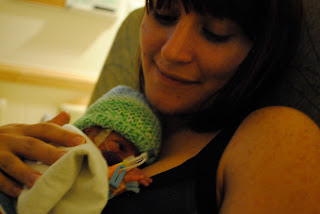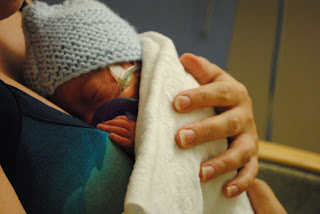Over a year later, and I still have trouble thinking about it for too long. Like if I relive too much, the ending will change. I think of the other babies and mothers fighting through this devastating disease, and I go numb. But what can I do? In the grand scheme of things, relatively little. But I can share our story in the hopes that it reaches someone who needs it.
******
This story has a happy ending. I say this now because it gets a little
dodgy in the middle, and if you are anything like me, someone who has only seen
the ending of West Side Story once out
of one hundred viewings, you avoid the tragic.
This is the birth story of the our
identical twin boys and the disease that plagued us along the way, Twin to Twin Transfusion Syndrome. At six
weeks, we were thrilled to find out through an emergency ultra sound and the
technician’s use of the word “they” that we were having twins. At sixteen weeks, we received the
devastating news that we suffered from Twin to Twin Transfusion Syndrome.
If you don’t know what TTTS is, you
are in the majority. Twin to Twin
Transfusion can happen when identical twins share the same placenta. Eighty-five percent of the time, the
single placenta acts like two separate placentas, keeping the blood flow and
nutrients of each baby separate from the other. In the other fifteen percent, connections happen within the placenta
that result in the unequal sharing of blood and nutrients between the
twins. One twin becomes the donor
and the other becomes the recipient; both in a life threatening position. If left untreated, the chance of
survival for both babies is nearly zero percent.
| Picture courtesy of http://www.tttsfoundation.org |
This was all being explained to me
as I sat alone and panicking in the ultrasound room after being diagnosed with
this terrifying disease. There are
several options at this point. Do
nothing, abort one of the babies, amniocentesis to remove excess fluid around
the recipient baby, and finally a laser surgery to seal off the connections
in the placenta, helping it to function more properly. The last option came with a
seventy-five percent survival rate for both babies, so I immediately scheduled
my surgery. I left the hospital
and called my husband, no answer; I called my mother, my middle sister, my
little sister, nobody answered. I
finally reached my best friend. She could barely understand what I was saying in my hysteria. When my husband came home I sat wrapped
in his arms with my hand on my belly, crying, weeping, sobbing and praying that I would get to
see my babies alive.
But then, over the course of a
sleepless night, I realized that I could not continue carrying on like an
emotional wreck. This was going to be an extremely difficult road, and the last
thing the babies needed was an unstable mother. I wanted them to be able to draw strength from me, and since
treating this disease was entirely out of my hands, I felt like this was the
one thing I could do for them. I
needed to do this; I needed to at least try. So we charged ahead.
In the longer version of this story
I would explain the details of my surgery, which happened around Mother's Day, that our case had the most placenta
connections our doctor had ever seen.
I would have you imagine our excitement in finding out that it had
worked and our devastation in finding out that it had come back a few weeks later. I would explain the details of my
second surgery, which fell a couple of days before Father's Day, comparing the anxieties between not knowing and knowing what to
expect this second time around. I
would express our cautious acknowledgement that the second surgery was
successful. (Although if you really want to know you can read about it here.)
I will summarize by saying this: every
day was potentially the last day I had with the little ones I was trying to
keep safe. Forget living day-to-day,
I was living hour- to-hour. I had
to dig deep to try to balance this anxiety with my resolve to remain
strong. But at times, it was all just too much. Luckily, I had a support
system that could keep a house up in a tornado.
My
hypersensitivity compelled me to make an impromptu hospital trip when I felt
like something wasn’t quite right.
I was dilated one centimeter and they kept me for
observation. This was at 27 weeks,
that is 13 weeks too early for those keeping track at home. The next morning my water broke and I
was told I would be taking up residence in the hospital until the babies
arrived, which everyone hoped would not be for another couple of weeks. After one
week of hospital food and blood pressure readings every six hours, on August
first, which happens to be our two-year wedding anniversary, the boys decided
it was time.
Sawyer
and Greyson were delivered by cesarean section at 2:38 and 2:39 in the
afternoon, weighing in at 3 pounds 1 ounce and 3 pounds 4 ounces. They were tiny, but perfect. We gave them each a kiss before they
were taken to the Neonatal Intensive Care Unit, a place that would become a
second home for us for the following two months, but that is a story for a
different day.
The
day that we brought them home, oxygen tank, heart monitor, and all, our TTTS saga was finally coming to an end and the real work of
raising twins began. All of the
work, all of the heartache, all of the anxiety, all of the hope had brought our
two little ones into this world and home safely, and I would do it all over again
– every single time.
This
story has a bit of a moral; maybe it is more of a message. This is a rare disease, and we were
lucky to be at a a hospital with a leading expert in the treatment of Twin to
Twin Transfusion Syndrome. Other
women and babies are not so fortunate.
The way to fight this killer is to catch it early and monitor it
closely. After reading this story,
you are now in the know. If you
told one other person, and that person told another, and so on, this
information may end up reaching a person who may really need it. You may help save a life, or two. And don't mistake that last sentence for a trivial, sentimental way to wrap up this story. It is simply the truth.




